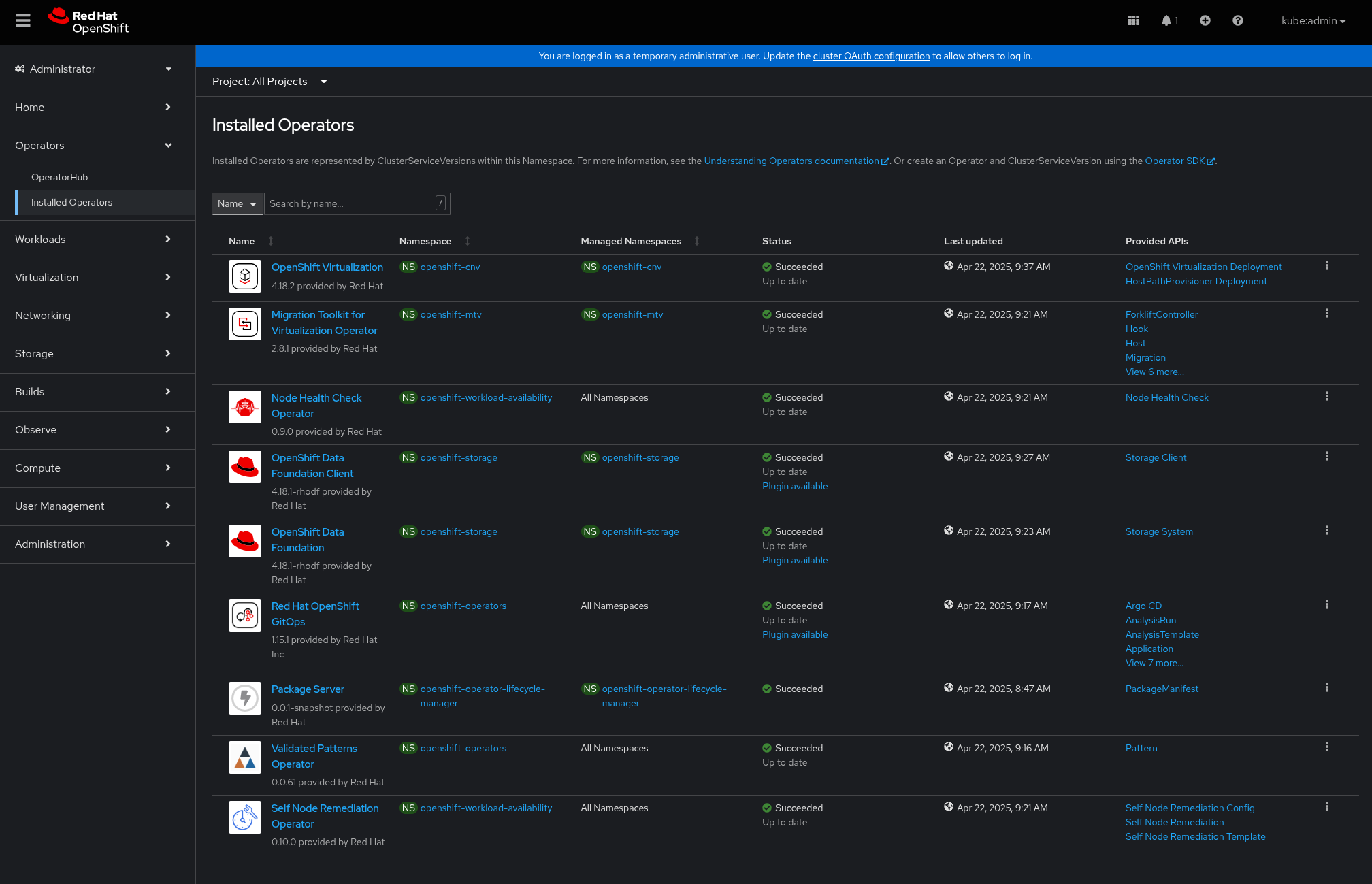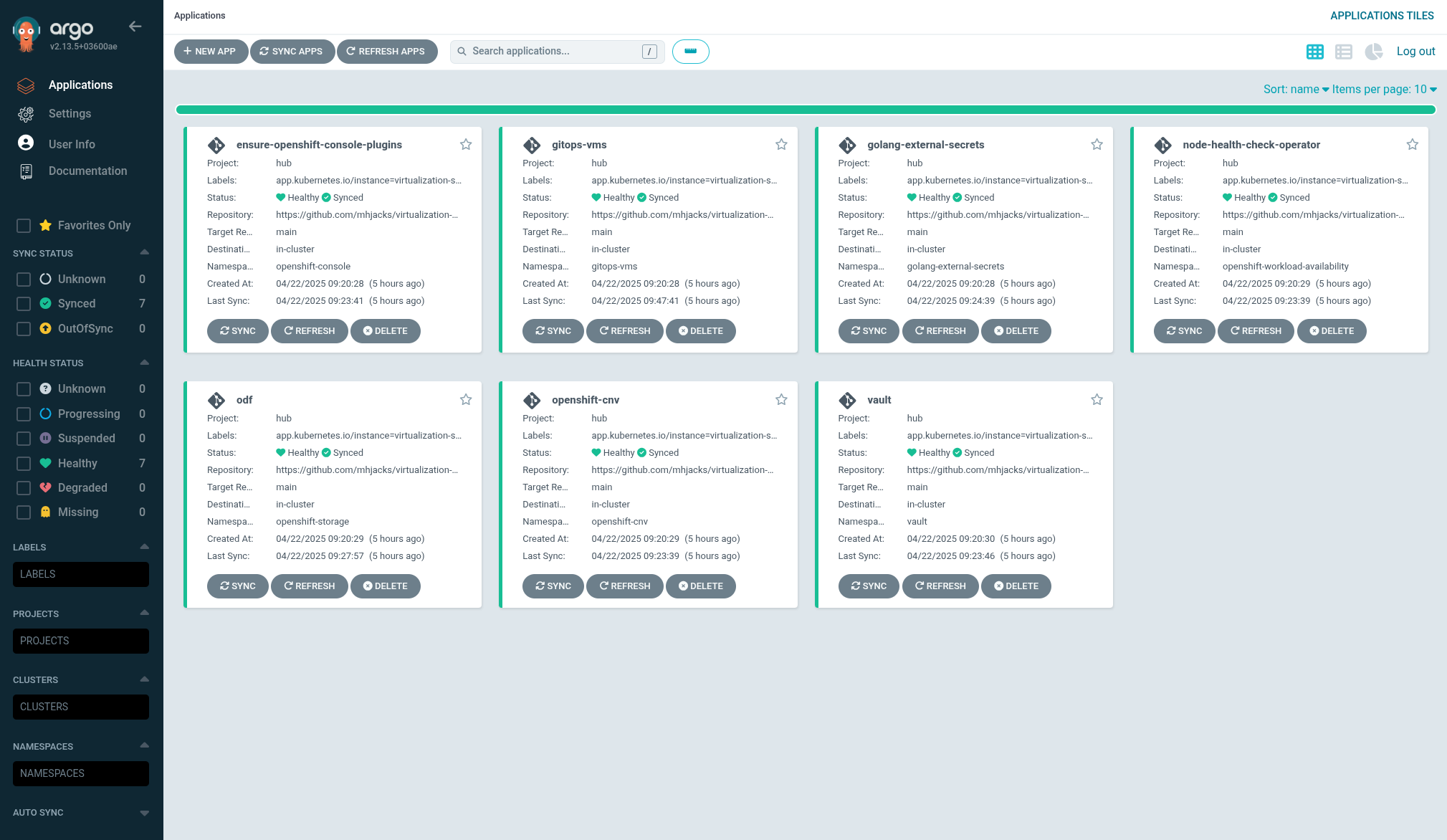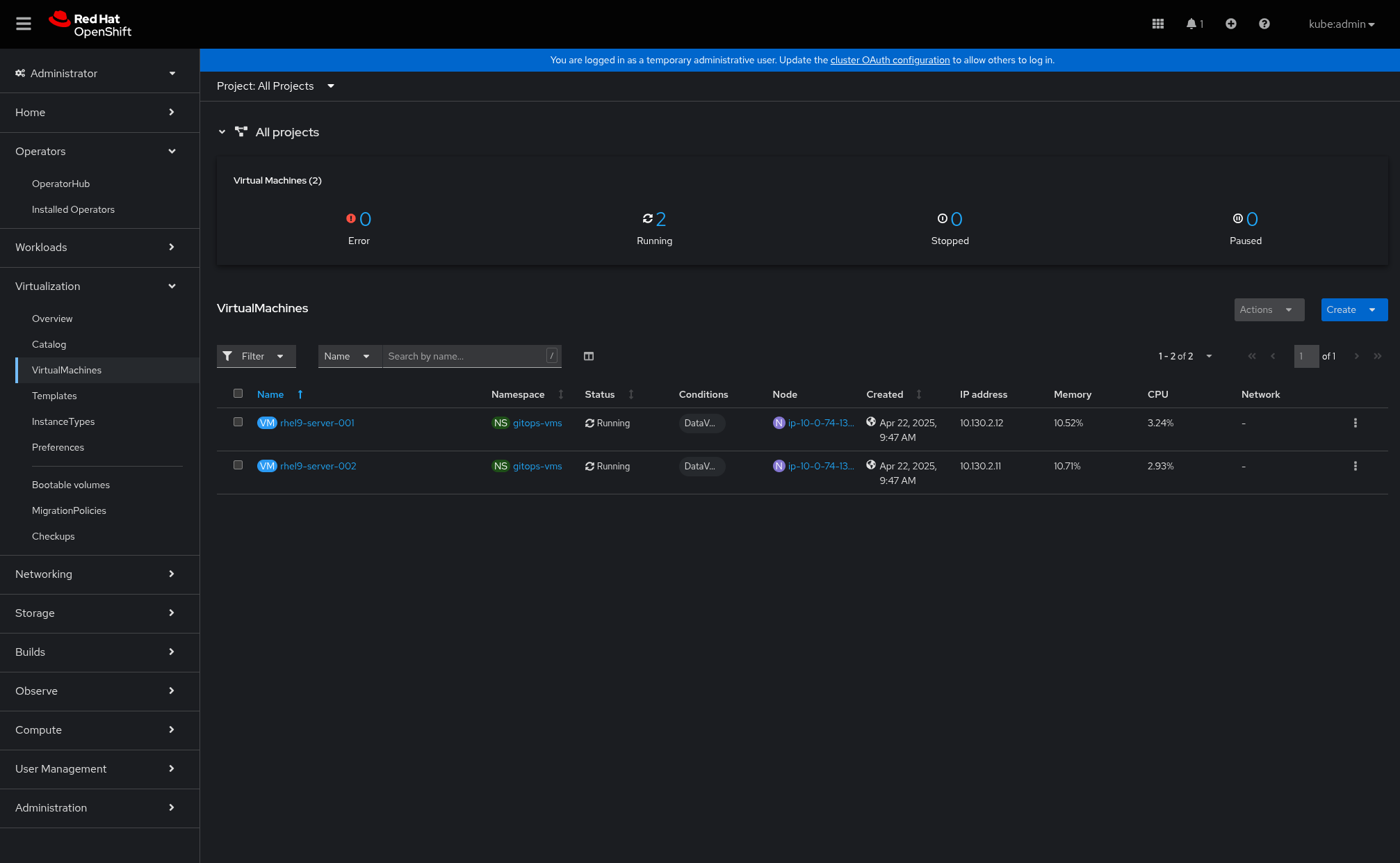Deploying the Virtualization Starter Kit Pattern
General Prerequisites
- An OpenShift cluster ( Go to the OpenShift console). Currently this pattern only supports AWS. It could also run on a baremetal OpenShift cluster, because OpenShift Virtualization supports that; there would need to be some customizations made to support it as the default is AWS. We hope that GCP and Azure will support provisioning metal workers in due course so this can be a more clearly multicloud pattern.
- A GitHub account (and, optionally, a token for it with repositories permissions, to read from and write to your forks)
- The helm binary, see here
- Ansible, which is used in the bootstrap and provisioning phases of the pattern install (and to configure Ansible Automation Platform).
- Please note that when run on AWS, this pattern will provision an additional worker node per availability zone (AZ) that the pattern is deployed in, which will be a metal instance (c5.metal) to run the Virtual Machines. These workers are provisioned through the OpenShift MachineAPI and will be automatically cleaned up when the cluster is destroyed.
The use of this pattern depends on having a running Red Hat OpenShift cluster. It is desirable to have a cluster for deploying the GitOps management hub assets and a separate cluster(s) for the managed cluster(s).
If you do not have a running Red Hat OpenShift cluster you can start one on a public or private cloud by using Red Hat’s cloud service.
Credentials Required in Pattern
In addition to the openshift cluster, you will need to prepare a number of secrets, or credentials, which will be used
in the pattern in various ways. To do this, copy the values-secret.yaml template to your home directory as values-secret.yaml and replace the explanatory text as follows:
- A username and SSH Keypair (private key and public key). These will be used to provide access to the VMs in the demo.
# NEVER COMMIT THESE VALUES TO GIT
version: "2.0"
secrets:
- name: vm-ssh
fields:
- name: username
value: 'Username of user to attach privatekey and publickey to - cloud-user is a typical value'
- name: privatekey
value: 'Private ssh key of the user who will be able to elevate to root on VMs'
- name: publickey
value: 'Public ssh key of the user who will be able to elevate to root on VMs'
- A userData block to use with cloud-init. This will allow console login as the user you specify (traditionally cloud-user) with the password you specify. The value in cloud-init is used as the default; roles in the edge-gitops-vms chart can also specify other secrets to use by referencing them in the role block.
- name: cloud-init
fields:
- name: userData
value: |-
#cloud-config
user: 'username of user for console, probably cloud-user'
password: 'a suitable password to use on the console'
chpasswd: { expire: False }
Prerequisites for deployment via make install
There are no special prerequisites to install this pattern.
How to deploy
Login to your cluster using oc login or exporting the KUBECONFIG
oc loginor set KUBECONFIG to the path to your
kubeconfigfile. For example:export KUBECONFIG=~/my-ocp-env/hub/auth/kubeconfigFork the virtualization-starter-kit repo on GitHub. It is necessary to fork to preserve customizations you make to the default configuration files.
Clone the forked copy of this repository.
git clone git@github.com:your-username/virtualization-starter-kit.gitCreate a local copy of the Helm values file that can safely include credentials
WARNING: DO NOT COMMIT THIS FILE
You do not want to push personal credentials to GitHub.
cp values-secret.yaml.template ~/values-secret.yaml vi ~/values-secret.yamlCustomize the deployment for your cluster (Optional - the defaults in values-global.yaml are designed to work in AWS):
git checkout -b my-branch vi values-global.yaml git add values-global.yaml git commit values-global.yaml git push origin my-branch
Please review the Patterns quick start page. This section describes deploying the pattern using pattern.sh. You can deploy the pattern using the validated pattern operator. If you do use the operator then skip to Validating the Environment below.
(Optional) Preview the changes. If you’d like to review what is been deployed with the pattern,
pattern.shprovides a way to show what will be deployed../pattern.sh make showApply the changes to your cluster. This will install the pattern via the Validated Patterns Operator, and then run any necessary follow-up steps.
./pattern.sh make install
The installation process will take between 45-60 minutes to complete. If you want to know the details of what is happening during that time, the entire process is documented here.
Installation Validation
Check the operators have been installed using the OpenShift console
OpenShift Console Web UI -> Installed Operators
The screen should like this when installed via make install:

- Check all applications are synchronised
Open the Hub ArgoCD instance from the nine-grid links menu. All applications will sync, but this takes time as ODF has to completely install, and OpenShift Virtualization cannot provision VMs until at least one metal node has been fully provisioned and ready.

While the metal node is building, the VMs in OpenShift console may not show up, or may show as “Unschedulable.” This is normal and expected, as the VMs themselves cannot run until the metal node completes provisioning and is ready.
Under Virtualization > Virtual Machines, the virtual machines will eventually show as “Running.” No additional configuration is done to the VMs beyond instantiating them; they are provided so you can do things like LiveMigrate them or do other virtualization “day 2” activities.

Please see Installation Details for more information on the steps of installation.
Please see OpenShift Virtualization for more information on how this pattern uses OpenShift Virtualization.
Infrastructure Elements of this Pattern
OpenShift Virtualization
OpenShift Virtualization is a Kubernetes-native way to run virtual machine workloads. It is used in this pattern to host VMs simulating an Edge environment; the chart that configures the VMs is designed to be flexible to allow easy customization to model different VM sizes, mixes, versions and profiles for future pattern development.
HashiCorp Vault
Vault is used as the authoritative source for the Kiosk ssh pubkey via the External Secrets Operator. As part of this pattern HashiCorp Vault has been installed. Refer to the section on Vault.
